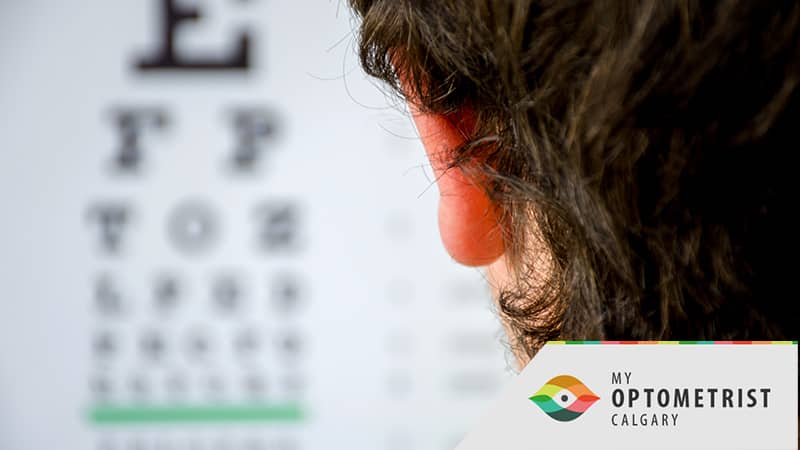
Light enters through the cornea and, since the front part of the eye is curved, this light bends. The crystalline lens helps to focus this light onto one spot on the retina and creates an upside down image. The brain then interprets this image as right side up. When the eye is misshapen, the light bends incorrectly and ends up focusing in the wrong spot. This is called a refractive error. Depending on how the eye is shaped and where the light focuses, these refractive errors have different names, the most common being astigmatism, hyperopia (farsightedness), myopia (nearsightedness) and presbyopia, although there are other less common refractive issues that can occur.
The Different Kinds Of Refractive Errors
Your vision can be impacted differently depending on the shape of your eye. Here are 7 ways that refractive errors can impact your vision and why.
1. Hyperopia (farsightedness)
In hyperopic eyes, the cornea is not curved enough or the eye shape is too short, which makes the light focus behind the retina. This improperly focused light means that objects that are far are clear and objects that are near are blurry.
2. Myopia (nearsightedness)
In myopic eyes, the cornea is too curved or the eye shape is too elongated, which makes the light focus in front of the retina . This improperly focused light means that objects that are close are clear, but objects that are further away are blurry.
3. Astigmatism
Eyes with astigmatism curve improperly, with the eye shaped more like an egg than a sphere. This causes light to focus on two separate places on the retina. People with astigmatism have blurred vision for objects that are both near and far. Astigmatism rarely happens on it’s own and oftentimes happens in conjunction with myopia or hyperopia.
4. Presbyopia
People with presbyopia have difficulty focusing on objects up close but not far away objects. This condition commonly develops with age. If you are over age 40 and find yourself holding your devices or books farther from your eyes to read or if you find yourself struggling to focus more often, you are likely suffering from presbyopia.
5. Aniseikonia
This is a condition where the perception of the size of an object is different in each eye.
6. Anisometropia
This is a condition where each eye focuses on objects at different distances. For example, one eye may be nearsighted and the other eye can focus regularly (called simple anisometropia). This causes the eyes to not focus on the same point and since the brain struggles to process both images, one eye will be favoured. This favoring can lead to a lazy eye.
7. Aphakia
This is a condition where the eye is missing its crystalline lens, due to injury or surgery or as a birth condition. Without the lens, the eye cannot focus and you can struggle to see objects that are close to you or the vibrancy of colours.
Get Your Eyes Examined And Treat Your Refractive Errors
Whether you have experienced refractive errors like myopia or hyperopia all your life or if you have newly developed vision difficulties, such as presbyopia, My Optometrist can help. With two convenient locations in Calgary, Sunridge in the NW, and Sundance in the SE, and one in Three Hills, AB, My Optometrist is here to help you see clearly. For any vision issues you are experiencing, contact us at My Optometrist to book a comprehensive eye exam. As Calgary’s choice optometrist, My Optometrist offers eye exams with professional and experienced eye doctors. Don’t suffer through blurry vision any longer, call the trusted team at My Optometrist and start seeing life clearly.
FAQ
Q: How do I know when to book an eye exam?
A: Everyone should get one exam at 6 months old, another at 3 years old, and another at 5 years old. Between the ages of 5 and 19, you should be getting your eyes examined every year. Between ages 20 and 39 should get an eye exam every 2 or 3 years, adults between 40 and 64 should be getting their eye exam every 2 years, and adults 64 and over should be getting their eyes examined every year. Beyond this, you should visit the eye doctor any time you notice a decrease in vision clarity or any pain, rashes, drooping of the eyelids, or other cause for concern regarding your eye health.
Q: When should my child get their first eye exam?
A: Eye exams can start at 6 months. By the time your child is one year old they will have complete vision, including the ability to judge distance. You can start their eye exams as early as this, and can get them examined earlier if they show signs of amblyopia (lazy eye) or strabismus (crossed eyes) or any other signs that raise concern.
Q: What happens at an eye exam?
A: A comprehensive adult eye exam (for those between 19 and 64 years of age) at My Optometrist Calgary includes:
- A review of your past and present eye and general health issues, as well as your family history.
- A discussion of your visual needs at work or school, home and for leisure.
- Measurement of your current level of vision with and without your glasses or contact lenses, and determination of your prescription.
- Assessment of your ability to move and use both eyes together.
- Measurement of the pressure inside of your eyes.
- A visual field assessment to measure your peripheral vision.
- Careful examination of the health of your eyes inside and outside. Drops to dilate your pupils may be recommended and administered.
- A photograph of the back of your eyes.
- Recommendations for future care of your eyes and vision.